|
About This Activity:
Grade level: 7-12
Time: 50 minutes
See our
Teacher Tips
for standards, discussion ideas, and more.
|
Why is your shadow longer in winter than in summer? It's easy to see the answer if you have a "sun" and an orbiting "earth" to demonstrate. Like many other ancient people, the ancient Chacoans used the annual changes in shadows to measure the passage of time and the change of seasons.
In this activity you'll see how the earth's tilt on its axis changes the length of shadows. The earth's position relative to the sun also brings us the seasons.
Modeling the Seasons
is another easy activity you can do to see why those changes happen.
What you need:
• a dark room
• a basketball
• 6–8 small paper clips (size = #1)
• a large empty jar or coffee can (no lid)
• masking tape
• register tape
• 100-watt bulb (clear, unfrosted) with a stand
• a pen or pencil
• a protractor
|
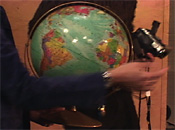
|
|
Astronomer Linda Shore demonstrates how the earth's tilted axis affects where sunlight strikes the earth as the planet orbits the sun. (
Watch movie
)
|
|
What To Do:
Place the basketball on top of the open end of the jar (or the coffee can). The jar will act as a stand for your basketball that is now a model of the earth. Place the lightbulb (the sun) about 6 feet away from the “earth.”
Next, cut a strip of register tape long enough to go from one pole of the basketball to the other. Using the masking tape, tape the ends of the register tape at “the poles” and note the position of the “earth’s” equator.

|
|
|
Linda shows proper clip-bending technique. (
Watch movie
)
|
Bend each paper clip so that the loops are at a 90-degree angle.
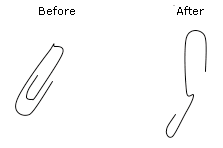
Hook each of the paper clips under the edge of the register tape so that one of the loops is pointing straight up. Use a small piece of masking tape to hold the paper clip in place. Each paper clip represents a tall object that will cast a shadow at noon. Make sure that you place paper clips above, below, and at the equator of your basketball. You might also want to place a paper clip at the approximate latitude of your hometown and at the north and south poles. In our example, we've labeled the basketball with the equator and the location of Chaco Canyon.
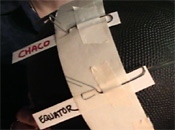
|
|
The locations of Chaco Canyon and the equator are labeled on the ball. (
Watch movie
)
|
|
|
Place the basketball (earth) in its stand and tip the northern hemisphere toward the lightbulb (sun) so that the North Pole is tipped 23.5° from the vertical base (see June 21 below). Use a protractor to measure the angle. This represents the earth’s position on or about June 21 (the summer solstice). NOTE: For December 21 (winter solstice), the northern hemisphere should be pointed away from the sun. On March 21 and September 21 (the equinoxes), the earth’s northern hemisphere isn't tipped either toward or away from the sun.

|
|
Image courtesy NASA
|
For each of the latitudes where you placed a paper clip marker, make a note of the shadow of the marker at noon. Is the paper clip casting a shadow? If so, is the shadow pointing north or south? Where on the earth are the shadows longer and where are the shadows shorter?

|
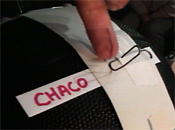
|
|
At noon at Chaco Canyon, the shadow points due north. (
Watch movie
)
|
|
What's Going On?
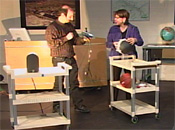
|
|
See why the shadows change length over the course of the year. (
Watch movie
)
|
The fact that length and orientation of noontime shadows are not the same over the course of the year is due to the tilt of the earth's axis. For example, at the equator, you may have noticed that on the spring and autumnal equinoxes, there are no shadows cast at noon. However, noontime shadows point north for northern latitudes (the shadow we're pointing to at Chaco) and south for southern latitudes. The closer you are to the poles, the longer the noontime shadows are.
What Else Can You Do?
Here are some things you might encourage your students to discover as they investigate sundial shadows all around the world:
• Where does your shadow point during the course of the day? Except for a few times during the year for latitudes between the Tropics of Cancer and Capricorn, shadows have a southerly projection during the day in the southern hemisphere. In the northern hemisphere, shadows have a northerly projection. Between the Tropics (23.5°N and 23.5°S latitudes), there are dates where the shadow points east-west, with no northerly or southerly projection. These are also the dates when the sun does not cast a shadow at noon (see next question).
• Where should you go on the earth if you want to cast no shadow at noon? That depends on the time of year. On June 21 (summer solstice), you want to be at 23.5°N (Tropic of Cancer); on December 21 (winter solstice), you want to be at 23.5°S (Tropic of Capricorn). On March 21 and September 21 (the vernal and autumnal equinoxes, respectively), you want to be at the equator. Any other date in the year, you’ll need to travel somewhere between these latitudes. The sun is never directly overhead for latitudes greater than 23.5°N or 23.5°S latitude.
• What kind of shadow do you cast at the north and south poles on the solstices? On the winter solstice (December 21), the sun does not rise at the North Pole—so there is no shadow. At the South Pole, the sun will be up all day on December 21—so you will cast a shadow all day. This shadow will trace out a 360° circle. Similarly, at the South Pole during the summer solstice (June 21), there is no sun so there is no shadow. And on that date at the North Pole, because the sun is up all day you will cast a shadow all day and it will also trace out a circle.












